Strategic Human Resource Management Report: Job Security and Design
VerifiedAdded on 2020/05/28
|18
|3996
|100
Report
AI Summary
This report delves into the critical role of job security and job design within the realm of strategic human resource management. It emphasizes the profound impact these factors have on both employee satisfaction and overall organizational success. The report meticulously examines the implications of poorly designed jobs, including lack of clarity, employee dissatisfaction, challenges in performance evaluation, and ultimately, diminished performance. Furthermore, it explores the adverse effects of lacking job security, such as fear, employee poaching, a focus on short-term goals, and again, poor performance. The report culminates in offering practical recommendations for HR managers to enhance employee satisfaction, improve performance, and foster effective employee retention. These recommendations encompass clear job roles, incentives and bonuses, transparent targets, improved communication channels, and the implementation of 360-degree feedback mechanisms.
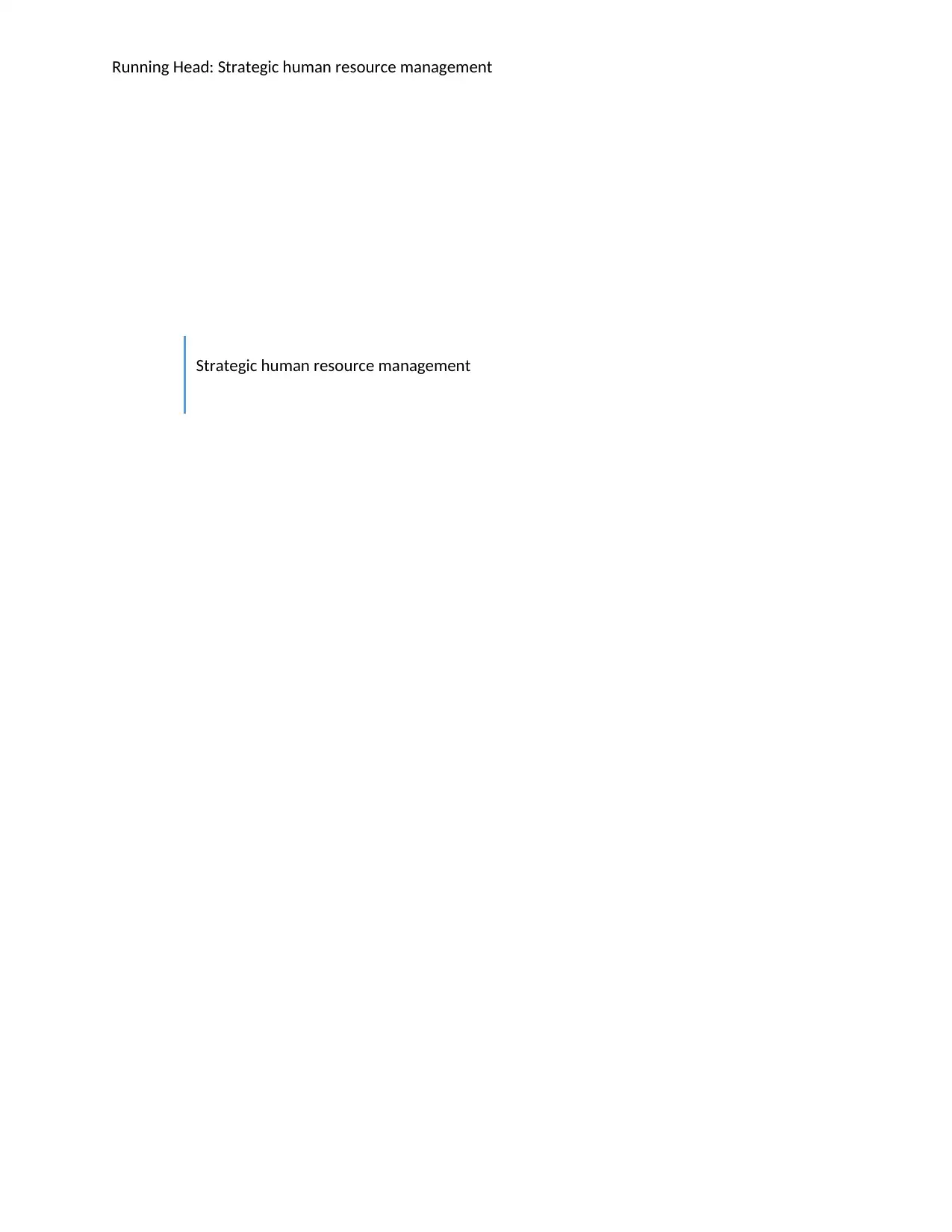
Running Head: Strategic human resource management
Strategic human resource management
Strategic human resource management
Paraphrase This Document
Need a fresh take? Get an instant paraphrase of this document with our AI Paraphraser
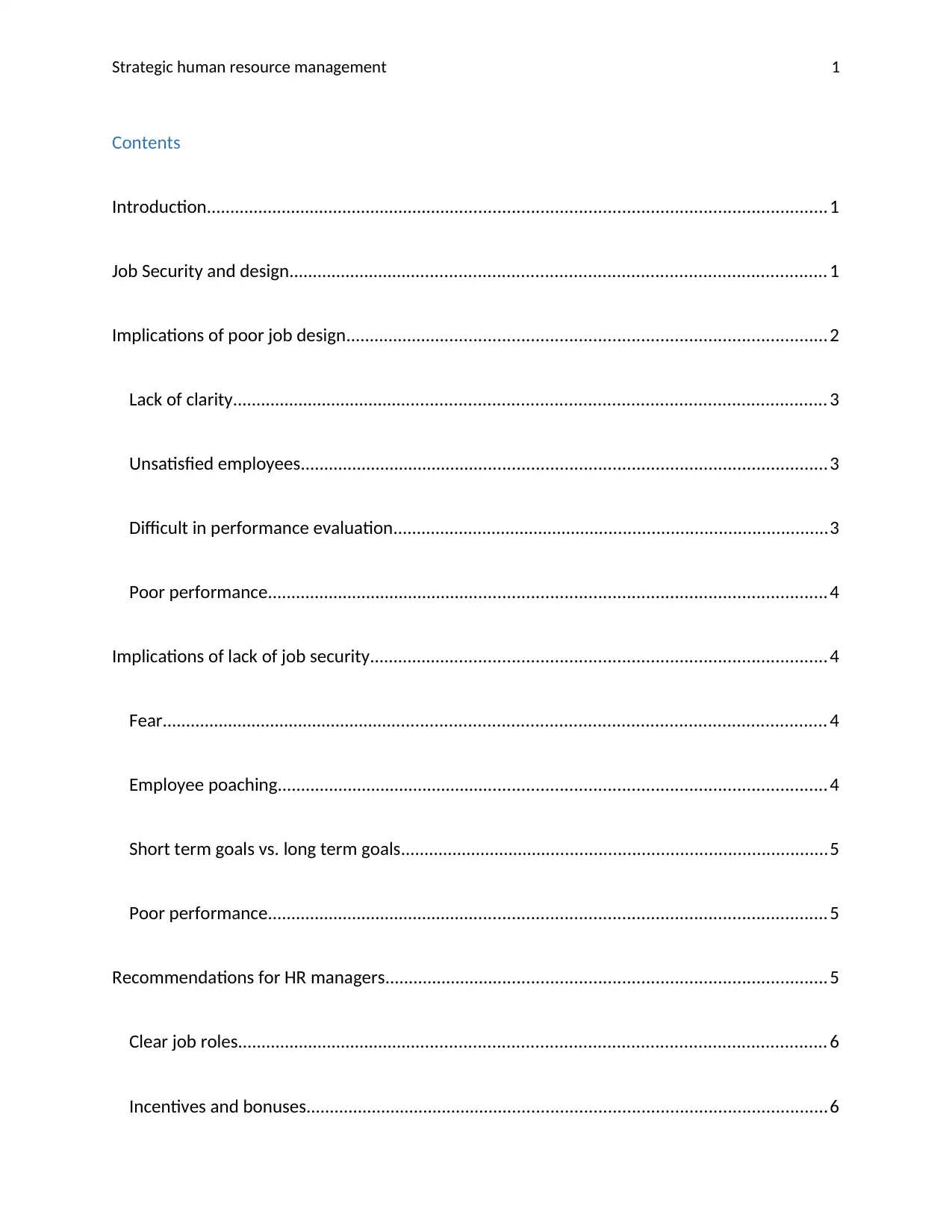
Strategic human resource management 1
Contents
Introduction...................................................................................................................................1
Job Security and design................................................................................................................. 1
Implications of poor job design..................................................................................................... 2
Lack of clarity............................................................................................................................. 3
Unsatisfied employees...............................................................................................................3
Difficult in performance evaluation............................................................................................3
Poor performance......................................................................................................................4
Implications of lack of job security................................................................................................4
Fear............................................................................................................................................ 4
Employee poaching....................................................................................................................4
Short term goals vs. long term goals..........................................................................................5
Poor performance......................................................................................................................5
Recommendations for HR managers.............................................................................................5
Clear job roles............................................................................................................................ 6
Incentives and bonuses..............................................................................................................6
Contents
Introduction...................................................................................................................................1
Job Security and design................................................................................................................. 1
Implications of poor job design..................................................................................................... 2
Lack of clarity............................................................................................................................. 3
Unsatisfied employees...............................................................................................................3
Difficult in performance evaluation............................................................................................3
Poor performance......................................................................................................................4
Implications of lack of job security................................................................................................4
Fear............................................................................................................................................ 4
Employee poaching....................................................................................................................4
Short term goals vs. long term goals..........................................................................................5
Poor performance......................................................................................................................5
Recommendations for HR managers.............................................................................................5
Clear job roles............................................................................................................................ 6
Incentives and bonuses..............................................................................................................6
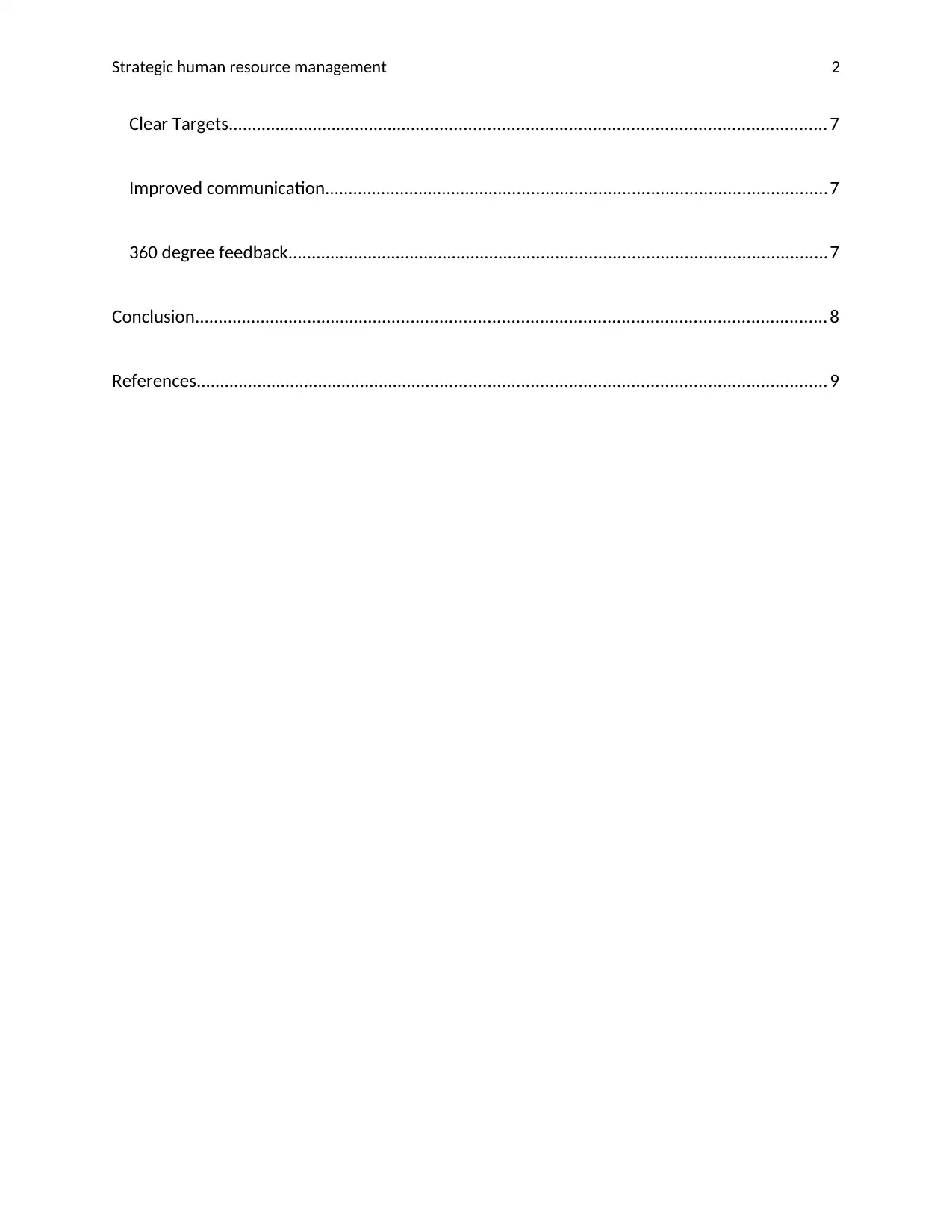
Strategic human resource management 2
Clear Targets.............................................................................................................................. 7
Improved communication..........................................................................................................7
360 degree feedback..................................................................................................................7
Conclusion..................................................................................................................................... 8
References..................................................................................................................................... 9
Clear Targets.............................................................................................................................. 7
Improved communication..........................................................................................................7
360 degree feedback..................................................................................................................7
Conclusion..................................................................................................................................... 8
References..................................................................................................................................... 9
⊘ This is a preview!⊘
Do you want full access?
Subscribe today to unlock all pages.

Trusted by 1+ million students worldwide
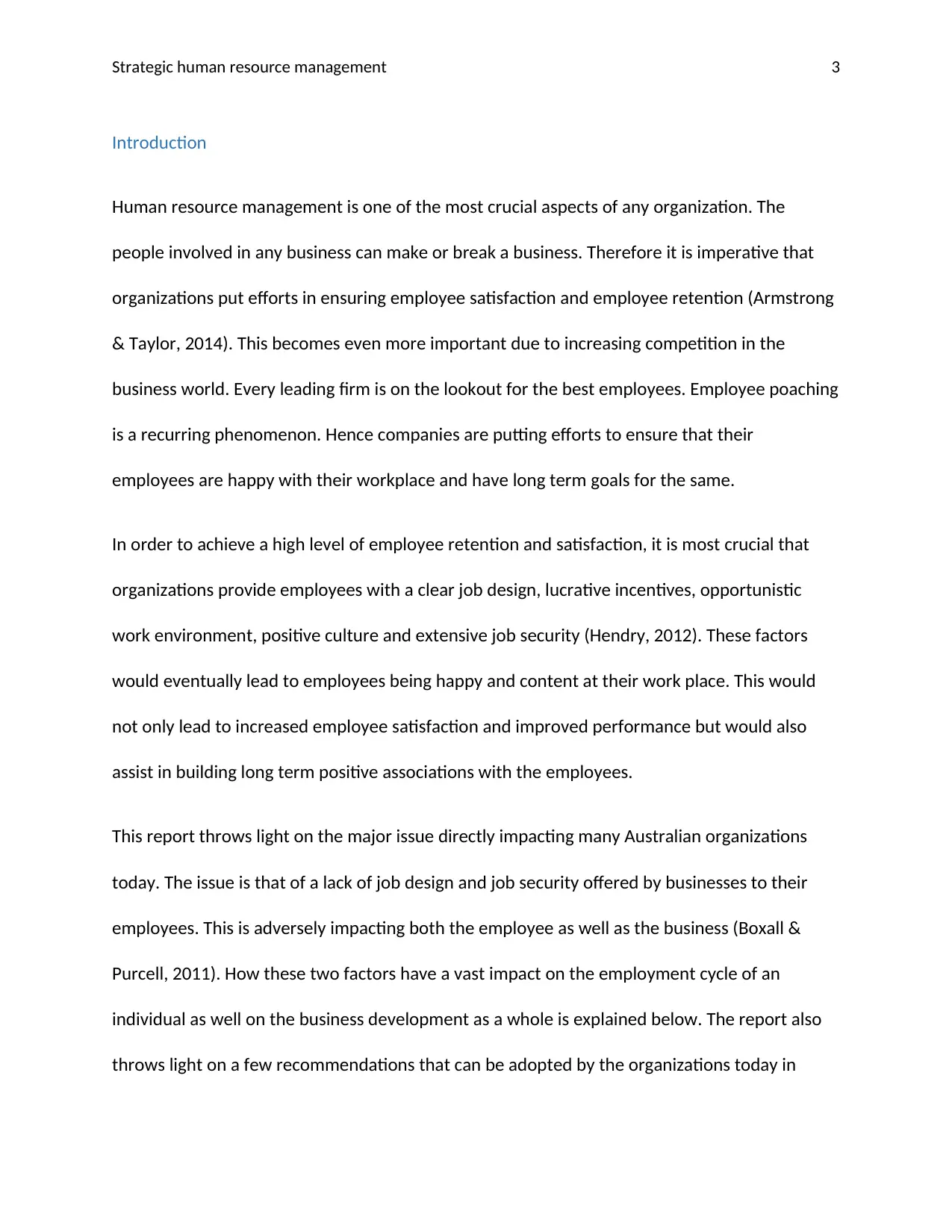
Strategic human resource management 3
Introduction
Human resource management is one of the most crucial aspects of any organization. The
people involved in any business can make or break a business. Therefore it is imperative that
organizations put efforts in ensuring employee satisfaction and employee retention (Armstrong
& Taylor, 2014). This becomes even more important due to increasing competition in the
business world. Every leading firm is on the lookout for the best employees. Employee poaching
is a recurring phenomenon. Hence companies are putting efforts to ensure that their
employees are happy with their workplace and have long term goals for the same.
In order to achieve a high level of employee retention and satisfaction, it is most crucial that
organizations provide employees with a clear job design, lucrative incentives, opportunistic
work environment, positive culture and extensive job security (Hendry, 2012). These factors
would eventually lead to employees being happy and content at their work place. This would
not only lead to increased employee satisfaction and improved performance but would also
assist in building long term positive associations with the employees.
This report throws light on the major issue directly impacting many Australian organizations
today. The issue is that of a lack of job design and job security offered by businesses to their
employees. This is adversely impacting both the employee as well as the business (Boxall &
Purcell, 2011). How these two factors have a vast impact on the employment cycle of an
individual as well on the business development as a whole is explained below. The report also
throws light on a few recommendations that can be adopted by the organizations today in
Introduction
Human resource management is one of the most crucial aspects of any organization. The
people involved in any business can make or break a business. Therefore it is imperative that
organizations put efforts in ensuring employee satisfaction and employee retention (Armstrong
& Taylor, 2014). This becomes even more important due to increasing competition in the
business world. Every leading firm is on the lookout for the best employees. Employee poaching
is a recurring phenomenon. Hence companies are putting efforts to ensure that their
employees are happy with their workplace and have long term goals for the same.
In order to achieve a high level of employee retention and satisfaction, it is most crucial that
organizations provide employees with a clear job design, lucrative incentives, opportunistic
work environment, positive culture and extensive job security (Hendry, 2012). These factors
would eventually lead to employees being happy and content at their work place. This would
not only lead to increased employee satisfaction and improved performance but would also
assist in building long term positive associations with the employees.
This report throws light on the major issue directly impacting many Australian organizations
today. The issue is that of a lack of job design and job security offered by businesses to their
employees. This is adversely impacting both the employee as well as the business (Boxall &
Purcell, 2011). How these two factors have a vast impact on the employment cycle of an
individual as well on the business development as a whole is explained below. The report also
throws light on a few recommendations that can be adopted by the organizations today in
Paraphrase This Document
Need a fresh take? Get an instant paraphrase of this document with our AI Paraphraser
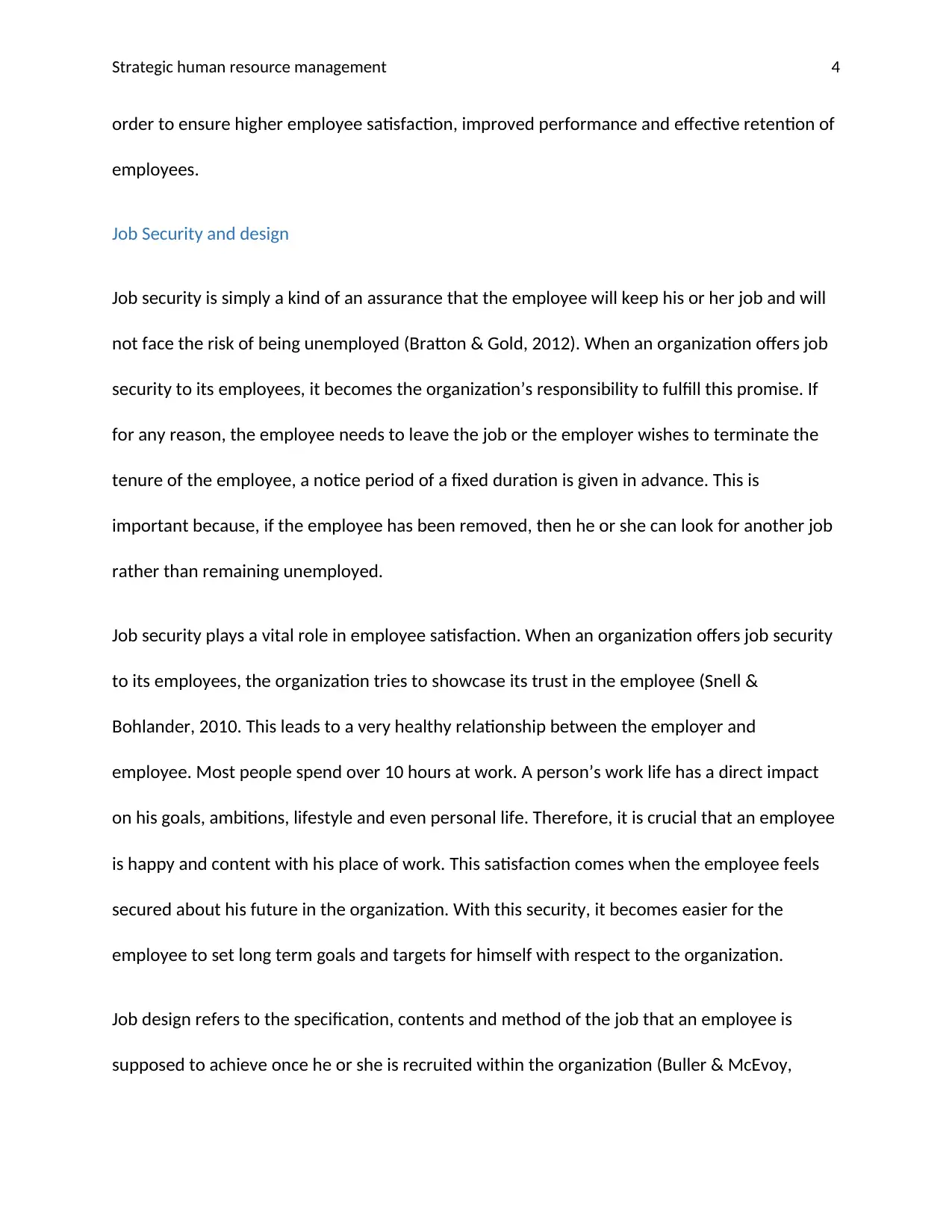
Strategic human resource management 4
order to ensure higher employee satisfaction, improved performance and effective retention of
employees.
Job Security and design
Job security is simply a kind of an assurance that the employee will keep his or her job and will
not face the risk of being unemployed (Bratton & Gold, 2012). When an organization offers job
security to its employees, it becomes the organization’s responsibility to fulfill this promise. If
for any reason, the employee needs to leave the job or the employer wishes to terminate the
tenure of the employee, a notice period of a fixed duration is given in advance. This is
important because, if the employee has been removed, then he or she can look for another job
rather than remaining unemployed.
Job security plays a vital role in employee satisfaction. When an organization offers job security
to its employees, the organization tries to showcase its trust in the employee (Snell &
Bohlander, 2010. This leads to a very healthy relationship between the employer and
employee. Most people spend over 10 hours at work. A person’s work life has a direct impact
on his goals, ambitions, lifestyle and even personal life. Therefore, it is crucial that an employee
is happy and content with his place of work. This satisfaction comes when the employee feels
secured about his future in the organization. With this security, it becomes easier for the
employee to set long term goals and targets for himself with respect to the organization.
Job design refers to the specification, contents and method of the job that an employee is
supposed to achieve once he or she is recruited within the organization (Buller & McEvoy,
order to ensure higher employee satisfaction, improved performance and effective retention of
employees.
Job Security and design
Job security is simply a kind of an assurance that the employee will keep his or her job and will
not face the risk of being unemployed (Bratton & Gold, 2012). When an organization offers job
security to its employees, it becomes the organization’s responsibility to fulfill this promise. If
for any reason, the employee needs to leave the job or the employer wishes to terminate the
tenure of the employee, a notice period of a fixed duration is given in advance. This is
important because, if the employee has been removed, then he or she can look for another job
rather than remaining unemployed.
Job security plays a vital role in employee satisfaction. When an organization offers job security
to its employees, the organization tries to showcase its trust in the employee (Snell &
Bohlander, 2010. This leads to a very healthy relationship between the employer and
employee. Most people spend over 10 hours at work. A person’s work life has a direct impact
on his goals, ambitions, lifestyle and even personal life. Therefore, it is crucial that an employee
is happy and content with his place of work. This satisfaction comes when the employee feels
secured about his future in the organization. With this security, it becomes easier for the
employee to set long term goals and targets for himself with respect to the organization.
Job design refers to the specification, contents and method of the job that an employee is
supposed to achieve once he or she is recruited within the organization (Buller & McEvoy,
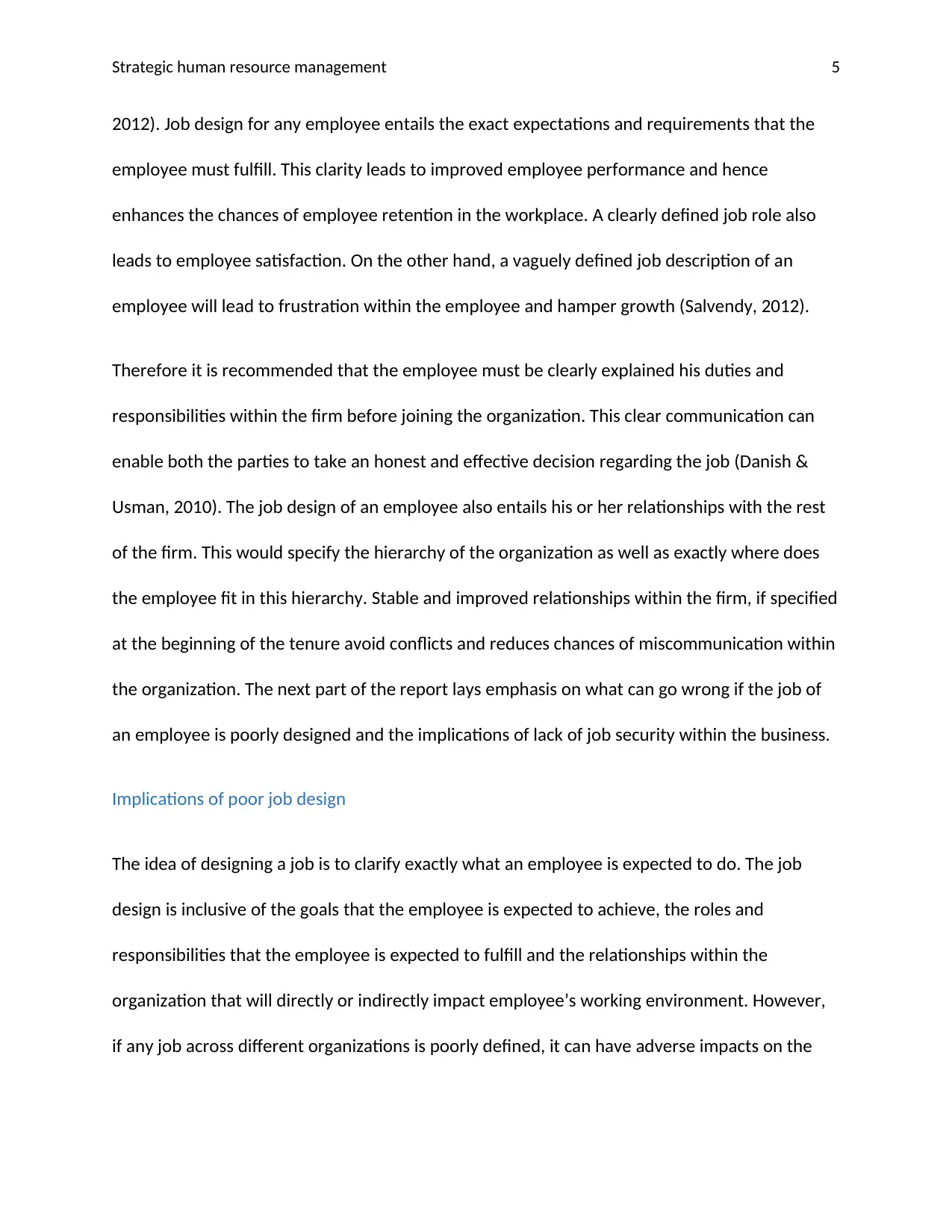
Strategic human resource management 5
2012). Job design for any employee entails the exact expectations and requirements that the
employee must fulfill. This clarity leads to improved employee performance and hence
enhances the chances of employee retention in the workplace. A clearly defined job role also
leads to employee satisfaction. On the other hand, a vaguely defined job description of an
employee will lead to frustration within the employee and hamper growth (Salvendy, 2012).
Therefore it is recommended that the employee must be clearly explained his duties and
responsibilities within the firm before joining the organization. This clear communication can
enable both the parties to take an honest and effective decision regarding the job (Danish &
Usman, 2010). The job design of an employee also entails his or her relationships with the rest
of the firm. This would specify the hierarchy of the organization as well as exactly where does
the employee fit in this hierarchy. Stable and improved relationships within the firm, if specified
at the beginning of the tenure avoid conflicts and reduces chances of miscommunication within
the organization. The next part of the report lays emphasis on what can go wrong if the job of
an employee is poorly designed and the implications of lack of job security within the business.
Implications of poor job design
The idea of designing a job is to clarify exactly what an employee is expected to do. The job
design is inclusive of the goals that the employee is expected to achieve, the roles and
responsibilities that the employee is expected to fulfill and the relationships within the
organization that will directly or indirectly impact employee’s working environment. However,
if any job across different organizations is poorly defined, it can have adverse impacts on the
2012). Job design for any employee entails the exact expectations and requirements that the
employee must fulfill. This clarity leads to improved employee performance and hence
enhances the chances of employee retention in the workplace. A clearly defined job role also
leads to employee satisfaction. On the other hand, a vaguely defined job description of an
employee will lead to frustration within the employee and hamper growth (Salvendy, 2012).
Therefore it is recommended that the employee must be clearly explained his duties and
responsibilities within the firm before joining the organization. This clear communication can
enable both the parties to take an honest and effective decision regarding the job (Danish &
Usman, 2010). The job design of an employee also entails his or her relationships with the rest
of the firm. This would specify the hierarchy of the organization as well as exactly where does
the employee fit in this hierarchy. Stable and improved relationships within the firm, if specified
at the beginning of the tenure avoid conflicts and reduces chances of miscommunication within
the organization. The next part of the report lays emphasis on what can go wrong if the job of
an employee is poorly designed and the implications of lack of job security within the business.
Implications of poor job design
The idea of designing a job is to clarify exactly what an employee is expected to do. The job
design is inclusive of the goals that the employee is expected to achieve, the roles and
responsibilities that the employee is expected to fulfill and the relationships within the
organization that will directly or indirectly impact employee’s working environment. However,
if any job across different organizations is poorly defined, it can have adverse impacts on the
⊘ This is a preview!⊘
Do you want full access?
Subscribe today to unlock all pages.

Trusted by 1+ million students worldwide
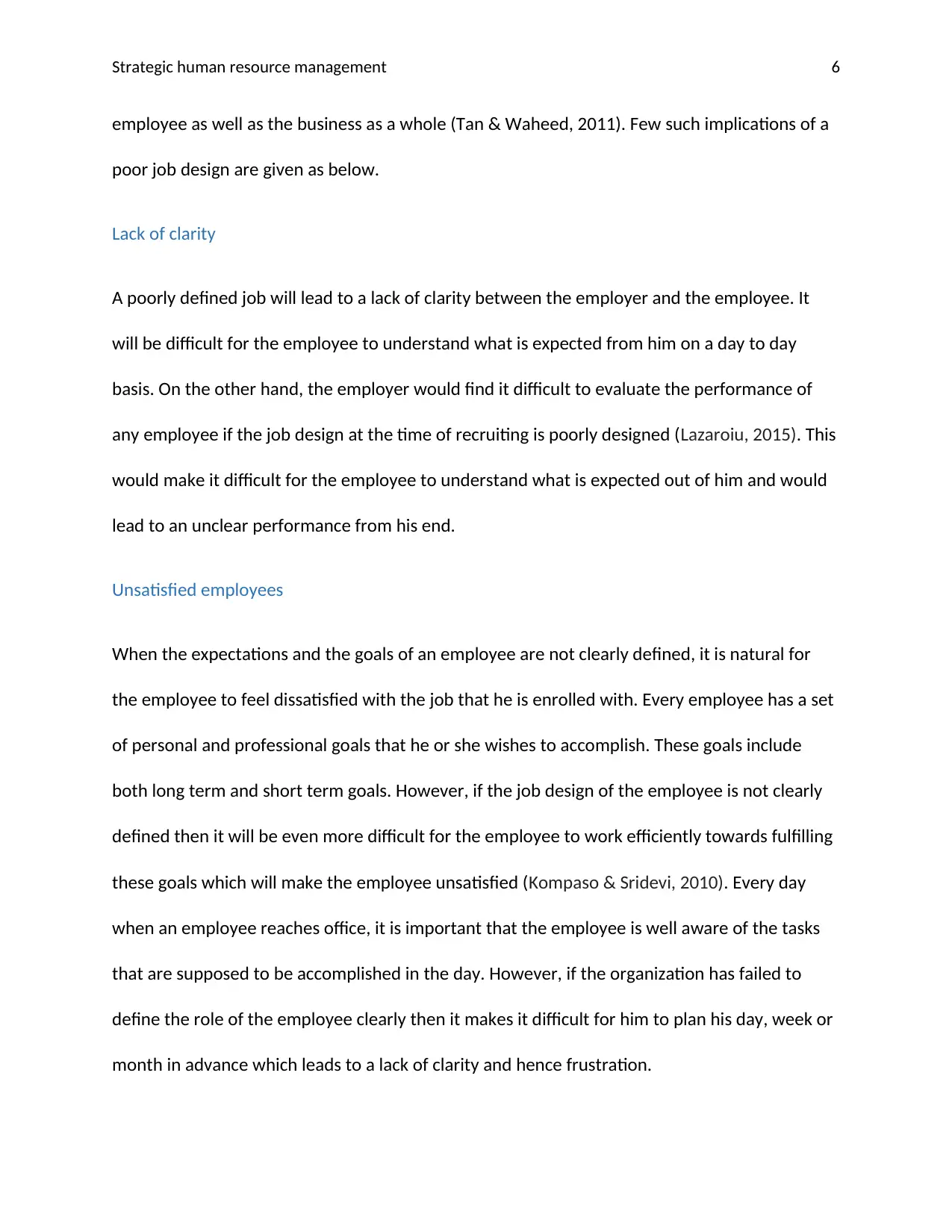
Strategic human resource management 6
employee as well as the business as a whole (Tan & Waheed, 2011). Few such implications of a
poor job design are given as below.
Lack of clarity
A poorly defined job will lead to a lack of clarity between the employer and the employee. It
will be difficult for the employee to understand what is expected from him on a day to day
basis. On the other hand, the employer would find it difficult to evaluate the performance of
any employee if the job design at the time of recruiting is poorly designed (Lazaroiu, 2015). This
would make it difficult for the employee to understand what is expected out of him and would
lead to an unclear performance from his end.
Unsatisfied employees
When the expectations and the goals of an employee are not clearly defined, it is natural for
the employee to feel dissatisfied with the job that he is enrolled with. Every employee has a set
of personal and professional goals that he or she wishes to accomplish. These goals include
both long term and short term goals. However, if the job design of the employee is not clearly
defined then it will be even more difficult for the employee to work efficiently towards fulfilling
these goals which will make the employee unsatisfied (Kompaso & Sridevi, 2010). Every day
when an employee reaches office, it is important that the employee is well aware of the tasks
that are supposed to be accomplished in the day. However, if the organization has failed to
define the role of the employee clearly then it makes it difficult for him to plan his day, week or
month in advance which leads to a lack of clarity and hence frustration.
employee as well as the business as a whole (Tan & Waheed, 2011). Few such implications of a
poor job design are given as below.
Lack of clarity
A poorly defined job will lead to a lack of clarity between the employer and the employee. It
will be difficult for the employee to understand what is expected from him on a day to day
basis. On the other hand, the employer would find it difficult to evaluate the performance of
any employee if the job design at the time of recruiting is poorly designed (Lazaroiu, 2015). This
would make it difficult for the employee to understand what is expected out of him and would
lead to an unclear performance from his end.
Unsatisfied employees
When the expectations and the goals of an employee are not clearly defined, it is natural for
the employee to feel dissatisfied with the job that he is enrolled with. Every employee has a set
of personal and professional goals that he or she wishes to accomplish. These goals include
both long term and short term goals. However, if the job design of the employee is not clearly
defined then it will be even more difficult for the employee to work efficiently towards fulfilling
these goals which will make the employee unsatisfied (Kompaso & Sridevi, 2010). Every day
when an employee reaches office, it is important that the employee is well aware of the tasks
that are supposed to be accomplished in the day. However, if the organization has failed to
define the role of the employee clearly then it makes it difficult for him to plan his day, week or
month in advance which leads to a lack of clarity and hence frustration.
Paraphrase This Document
Need a fresh take? Get an instant paraphrase of this document with our AI Paraphraser
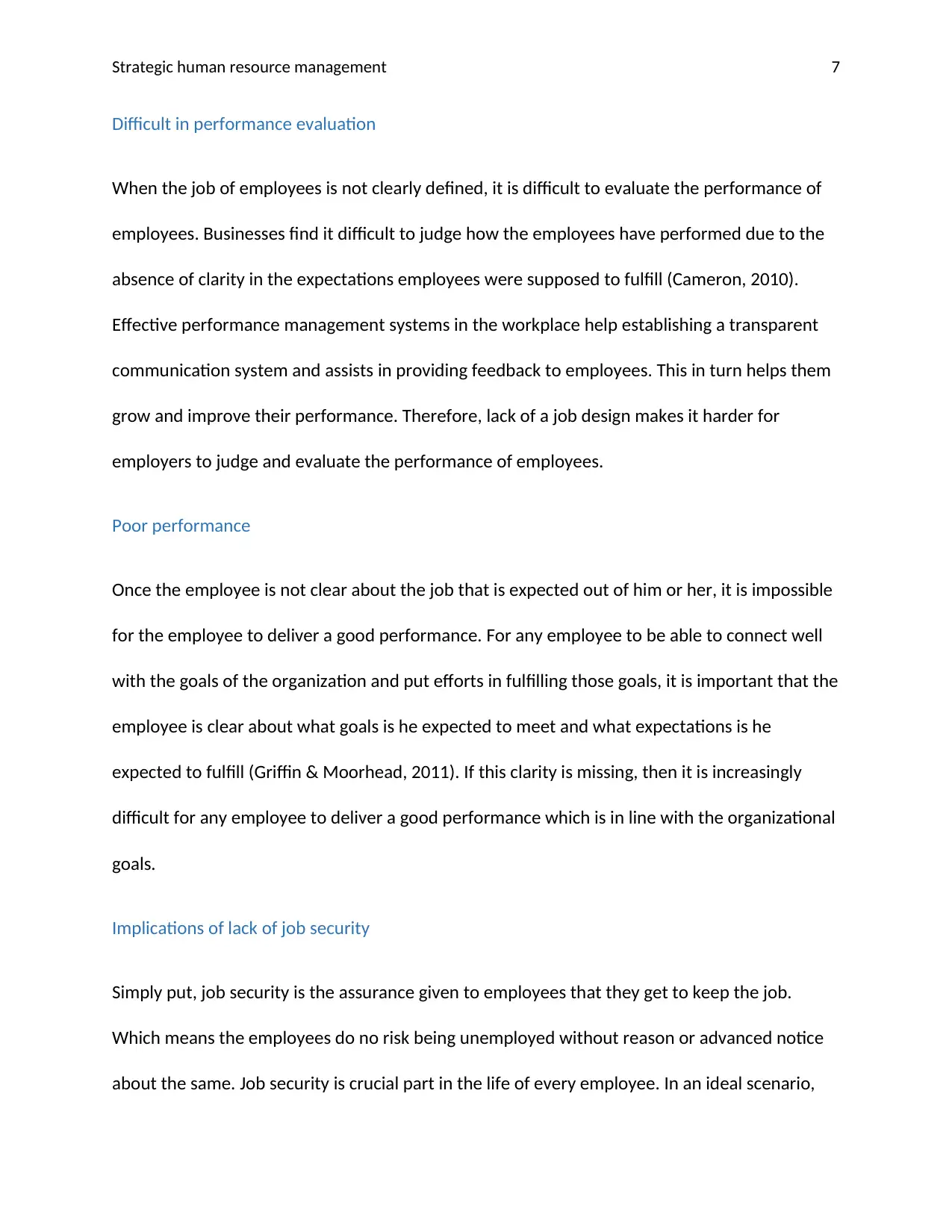
Strategic human resource management 7
Difficult in performance evaluation
When the job of employees is not clearly defined, it is difficult to evaluate the performance of
employees. Businesses find it difficult to judge how the employees have performed due to the
absence of clarity in the expectations employees were supposed to fulfill (Cameron, 2010).
Effective performance management systems in the workplace help establishing a transparent
communication system and assists in providing feedback to employees. This in turn helps them
grow and improve their performance. Therefore, lack of a job design makes it harder for
employers to judge and evaluate the performance of employees.
Poor performance
Once the employee is not clear about the job that is expected out of him or her, it is impossible
for the employee to deliver a good performance. For any employee to be able to connect well
with the goals of the organization and put efforts in fulfilling those goals, it is important that the
employee is clear about what goals is he expected to meet and what expectations is he
expected to fulfill (Griffin & Moorhead, 2011). If this clarity is missing, then it is increasingly
difficult for any employee to deliver a good performance which is in line with the organizational
goals.
Implications of lack of job security
Simply put, job security is the assurance given to employees that they get to keep the job.
Which means the employees do no risk being unemployed without reason or advanced notice
about the same. Job security is crucial part in the life of every employee. In an ideal scenario,
Difficult in performance evaluation
When the job of employees is not clearly defined, it is difficult to evaluate the performance of
employees. Businesses find it difficult to judge how the employees have performed due to the
absence of clarity in the expectations employees were supposed to fulfill (Cameron, 2010).
Effective performance management systems in the workplace help establishing a transparent
communication system and assists in providing feedback to employees. This in turn helps them
grow and improve their performance. Therefore, lack of a job design makes it harder for
employers to judge and evaluate the performance of employees.
Poor performance
Once the employee is not clear about the job that is expected out of him or her, it is impossible
for the employee to deliver a good performance. For any employee to be able to connect well
with the goals of the organization and put efforts in fulfilling those goals, it is important that the
employee is clear about what goals is he expected to meet and what expectations is he
expected to fulfill (Griffin & Moorhead, 2011). If this clarity is missing, then it is increasingly
difficult for any employee to deliver a good performance which is in line with the organizational
goals.
Implications of lack of job security
Simply put, job security is the assurance given to employees that they get to keep the job.
Which means the employees do no risk being unemployed without reason or advanced notice
about the same. Job security is crucial part in the life of every employee. In an ideal scenario,
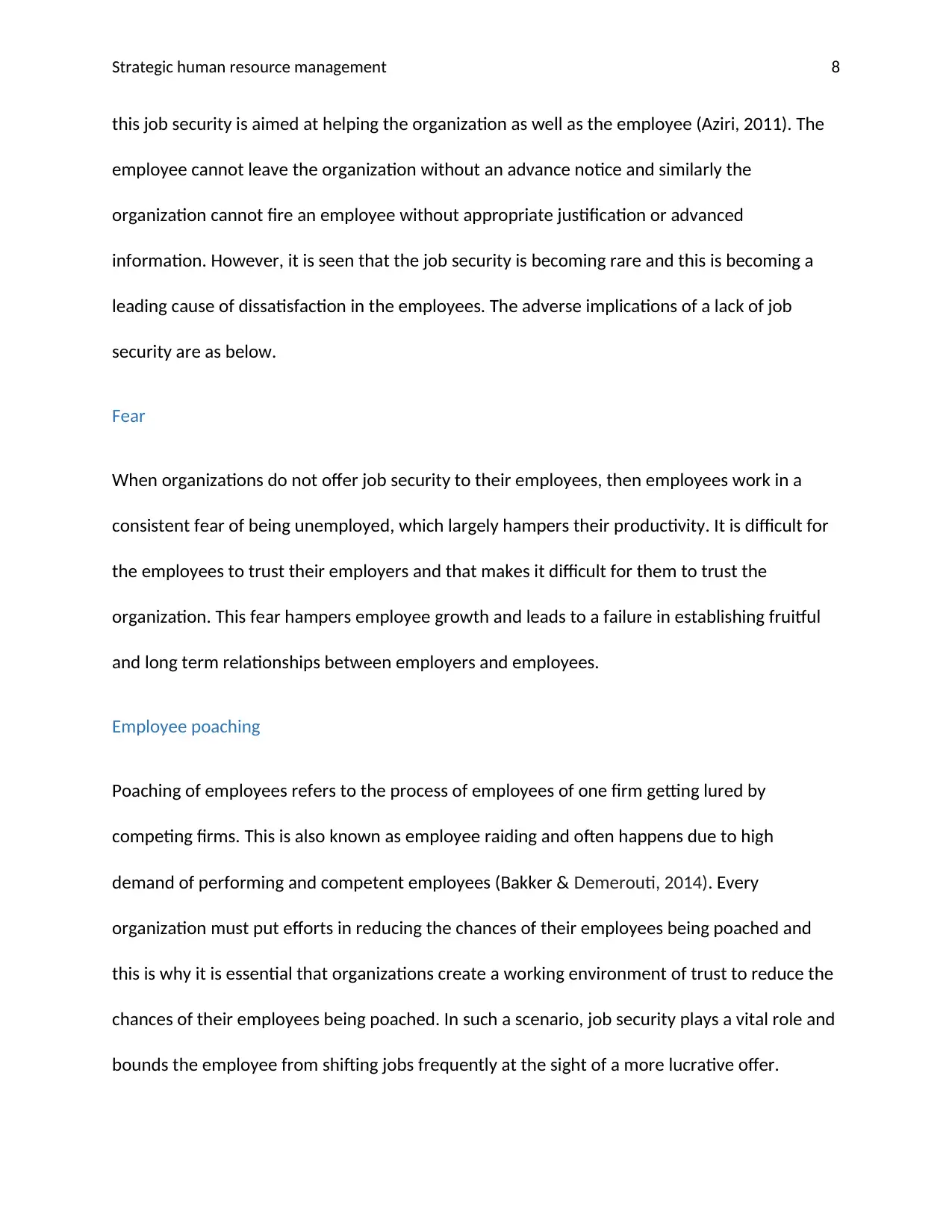
Strategic human resource management 8
this job security is aimed at helping the organization as well as the employee (Aziri, 2011). The
employee cannot leave the organization without an advance notice and similarly the
organization cannot fire an employee without appropriate justification or advanced
information. However, it is seen that the job security is becoming rare and this is becoming a
leading cause of dissatisfaction in the employees. The adverse implications of a lack of job
security are as below.
Fear
When organizations do not offer job security to their employees, then employees work in a
consistent fear of being unemployed, which largely hampers their productivity. It is difficult for
the employees to trust their employers and that makes it difficult for them to trust the
organization. This fear hampers employee growth and leads to a failure in establishing fruitful
and long term relationships between employers and employees.
Employee poaching
Poaching of employees refers to the process of employees of one firm getting lured by
competing firms. This is also known as employee raiding and often happens due to high
demand of performing and competent employees (Bakker & Demerouti, 2014). Every
organization must put efforts in reducing the chances of their employees being poached and
this is why it is essential that organizations create a working environment of trust to reduce the
chances of their employees being poached. In such a scenario, job security plays a vital role and
bounds the employee from shifting jobs frequently at the sight of a more lucrative offer.
this job security is aimed at helping the organization as well as the employee (Aziri, 2011). The
employee cannot leave the organization without an advance notice and similarly the
organization cannot fire an employee without appropriate justification or advanced
information. However, it is seen that the job security is becoming rare and this is becoming a
leading cause of dissatisfaction in the employees. The adverse implications of a lack of job
security are as below.
Fear
When organizations do not offer job security to their employees, then employees work in a
consistent fear of being unemployed, which largely hampers their productivity. It is difficult for
the employees to trust their employers and that makes it difficult for them to trust the
organization. This fear hampers employee growth and leads to a failure in establishing fruitful
and long term relationships between employers and employees.
Employee poaching
Poaching of employees refers to the process of employees of one firm getting lured by
competing firms. This is also known as employee raiding and often happens due to high
demand of performing and competent employees (Bakker & Demerouti, 2014). Every
organization must put efforts in reducing the chances of their employees being poached and
this is why it is essential that organizations create a working environment of trust to reduce the
chances of their employees being poached. In such a scenario, job security plays a vital role and
bounds the employee from shifting jobs frequently at the sight of a more lucrative offer.
⊘ This is a preview!⊘
Do you want full access?
Subscribe today to unlock all pages.

Trusted by 1+ million students worldwide
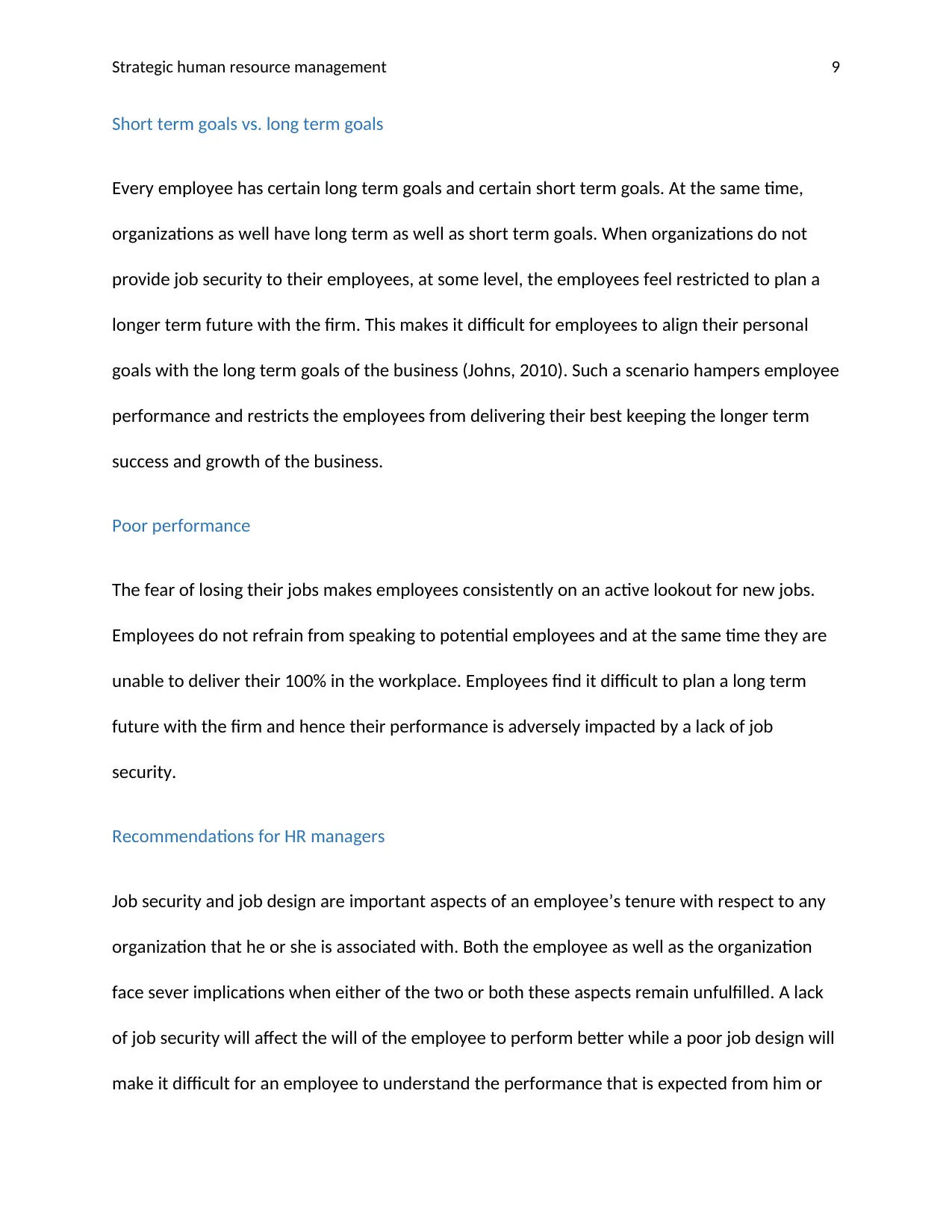
Strategic human resource management 9
Short term goals vs. long term goals
Every employee has certain long term goals and certain short term goals. At the same time,
organizations as well have long term as well as short term goals. When organizations do not
provide job security to their employees, at some level, the employees feel restricted to plan a
longer term future with the firm. This makes it difficult for employees to align their personal
goals with the long term goals of the business (Johns, 2010). Such a scenario hampers employee
performance and restricts the employees from delivering their best keeping the longer term
success and growth of the business.
Poor performance
The fear of losing their jobs makes employees consistently on an active lookout for new jobs.
Employees do not refrain from speaking to potential employees and at the same time they are
unable to deliver their 100% in the workplace. Employees find it difficult to plan a long term
future with the firm and hence their performance is adversely impacted by a lack of job
security.
Recommendations for HR managers
Job security and job design are important aspects of an employee’s tenure with respect to any
organization that he or she is associated with. Both the employee as well as the organization
face sever implications when either of the two or both these aspects remain unfulfilled. A lack
of job security will affect the will of the employee to perform better while a poor job design will
make it difficult for an employee to understand the performance that is expected from him or
Short term goals vs. long term goals
Every employee has certain long term goals and certain short term goals. At the same time,
organizations as well have long term as well as short term goals. When organizations do not
provide job security to their employees, at some level, the employees feel restricted to plan a
longer term future with the firm. This makes it difficult for employees to align their personal
goals with the long term goals of the business (Johns, 2010). Such a scenario hampers employee
performance and restricts the employees from delivering their best keeping the longer term
success and growth of the business.
Poor performance
The fear of losing their jobs makes employees consistently on an active lookout for new jobs.
Employees do not refrain from speaking to potential employees and at the same time they are
unable to deliver their 100% in the workplace. Employees find it difficult to plan a long term
future with the firm and hence their performance is adversely impacted by a lack of job
security.
Recommendations for HR managers
Job security and job design are important aspects of an employee’s tenure with respect to any
organization that he or she is associated with. Both the employee as well as the organization
face sever implications when either of the two or both these aspects remain unfulfilled. A lack
of job security will affect the will of the employee to perform better while a poor job design will
make it difficult for an employee to understand the performance that is expected from him or
Paraphrase This Document
Need a fresh take? Get an instant paraphrase of this document with our AI Paraphraser
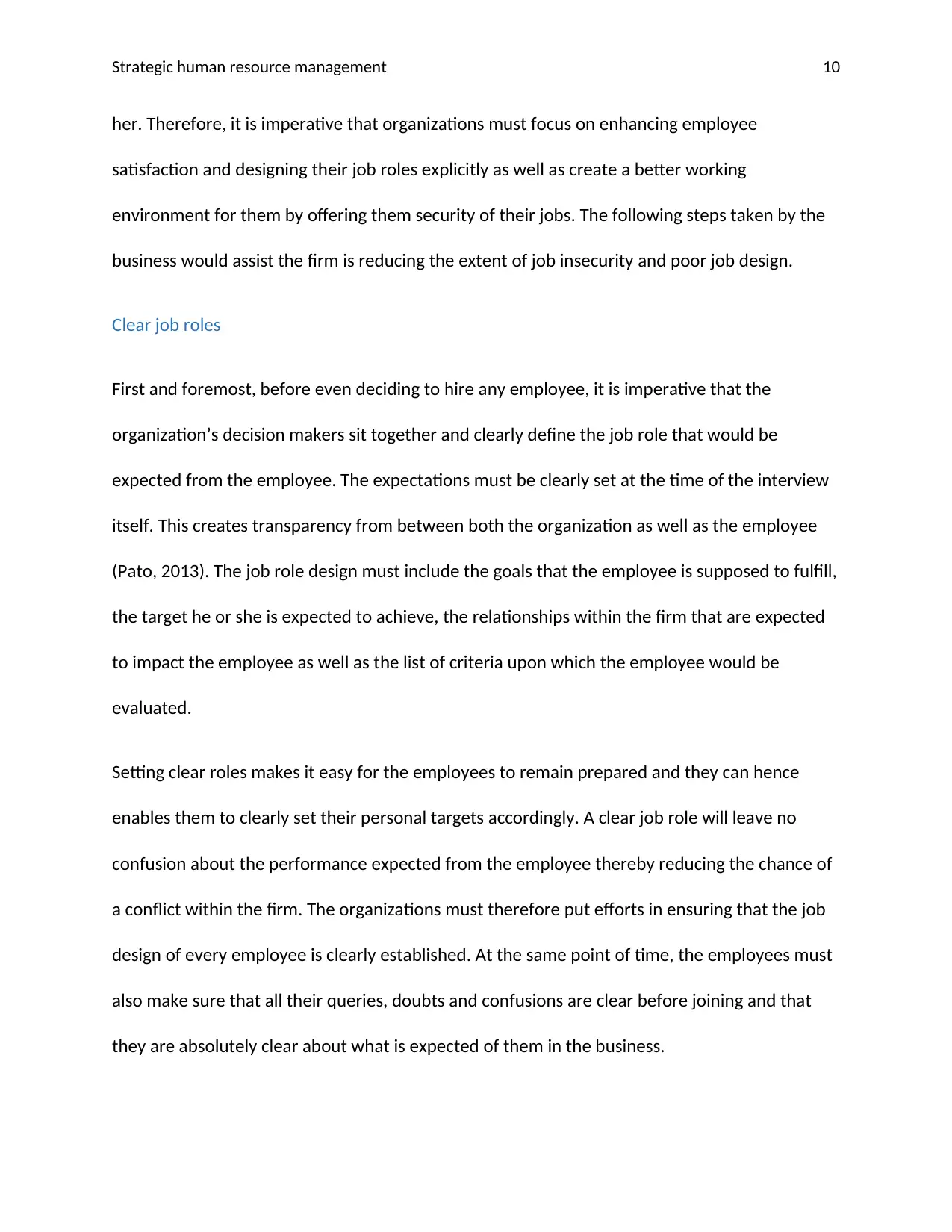
Strategic human resource management 10
her. Therefore, it is imperative that organizations must focus on enhancing employee
satisfaction and designing their job roles explicitly as well as create a better working
environment for them by offering them security of their jobs. The following steps taken by the
business would assist the firm is reducing the extent of job insecurity and poor job design.
Clear job roles
First and foremost, before even deciding to hire any employee, it is imperative that the
organization’s decision makers sit together and clearly define the job role that would be
expected from the employee. The expectations must be clearly set at the time of the interview
itself. This creates transparency from between both the organization as well as the employee
(Pato, 2013). The job role design must include the goals that the employee is supposed to fulfill,
the target he or she is expected to achieve, the relationships within the firm that are expected
to impact the employee as well as the list of criteria upon which the employee would be
evaluated.
Setting clear roles makes it easy for the employees to remain prepared and they can hence
enables them to clearly set their personal targets accordingly. A clear job role will leave no
confusion about the performance expected from the employee thereby reducing the chance of
a conflict within the firm. The organizations must therefore put efforts in ensuring that the job
design of every employee is clearly established. At the same point of time, the employees must
also make sure that all their queries, doubts and confusions are clear before joining and that
they are absolutely clear about what is expected of them in the business.
her. Therefore, it is imperative that organizations must focus on enhancing employee
satisfaction and designing their job roles explicitly as well as create a better working
environment for them by offering them security of their jobs. The following steps taken by the
business would assist the firm is reducing the extent of job insecurity and poor job design.
Clear job roles
First and foremost, before even deciding to hire any employee, it is imperative that the
organization’s decision makers sit together and clearly define the job role that would be
expected from the employee. The expectations must be clearly set at the time of the interview
itself. This creates transparency from between both the organization as well as the employee
(Pato, 2013). The job role design must include the goals that the employee is supposed to fulfill,
the target he or she is expected to achieve, the relationships within the firm that are expected
to impact the employee as well as the list of criteria upon which the employee would be
evaluated.
Setting clear roles makes it easy for the employees to remain prepared and they can hence
enables them to clearly set their personal targets accordingly. A clear job role will leave no
confusion about the performance expected from the employee thereby reducing the chance of
a conflict within the firm. The organizations must therefore put efforts in ensuring that the job
design of every employee is clearly established. At the same point of time, the employees must
also make sure that all their queries, doubts and confusions are clear before joining and that
they are absolutely clear about what is expected of them in the business.
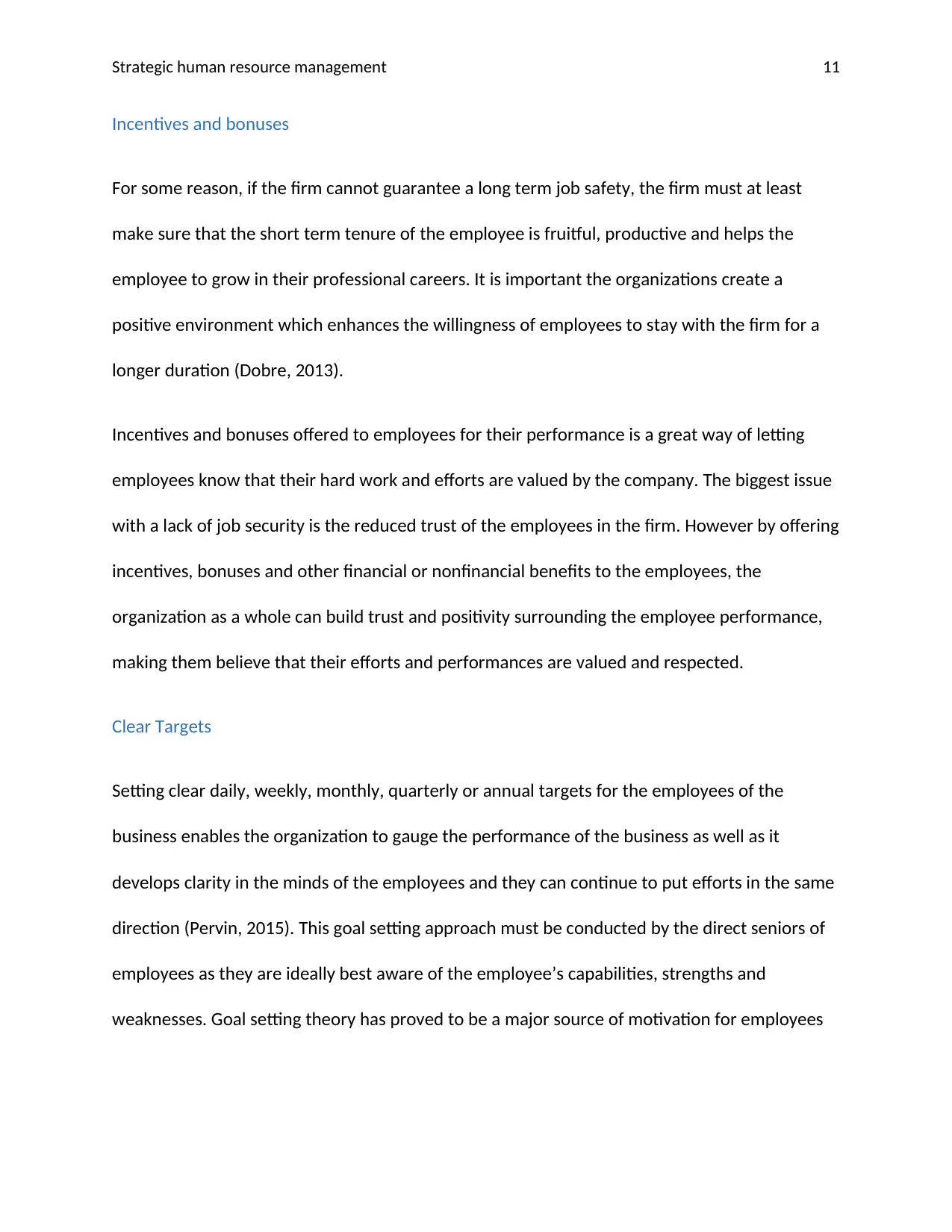
Strategic human resource management 11
Incentives and bonuses
For some reason, if the firm cannot guarantee a long term job safety, the firm must at least
make sure that the short term tenure of the employee is fruitful, productive and helps the
employee to grow in their professional careers. It is important the organizations create a
positive environment which enhances the willingness of employees to stay with the firm for a
longer duration (Dobre, 2013).
Incentives and bonuses offered to employees for their performance is a great way of letting
employees know that their hard work and efforts are valued by the company. The biggest issue
with a lack of job security is the reduced trust of the employees in the firm. However by offering
incentives, bonuses and other financial or nonfinancial benefits to the employees, the
organization as a whole can build trust and positivity surrounding the employee performance,
making them believe that their efforts and performances are valued and respected.
Clear Targets
Setting clear daily, weekly, monthly, quarterly or annual targets for the employees of the
business enables the organization to gauge the performance of the business as well as it
develops clarity in the minds of the employees and they can continue to put efforts in the same
direction (Pervin, 2015). This goal setting approach must be conducted by the direct seniors of
employees as they are ideally best aware of the employee’s capabilities, strengths and
weaknesses. Goal setting theory has proved to be a major source of motivation for employees
Incentives and bonuses
For some reason, if the firm cannot guarantee a long term job safety, the firm must at least
make sure that the short term tenure of the employee is fruitful, productive and helps the
employee to grow in their professional careers. It is important the organizations create a
positive environment which enhances the willingness of employees to stay with the firm for a
longer duration (Dobre, 2013).
Incentives and bonuses offered to employees for their performance is a great way of letting
employees know that their hard work and efforts are valued by the company. The biggest issue
with a lack of job security is the reduced trust of the employees in the firm. However by offering
incentives, bonuses and other financial or nonfinancial benefits to the employees, the
organization as a whole can build trust and positivity surrounding the employee performance,
making them believe that their efforts and performances are valued and respected.
Clear Targets
Setting clear daily, weekly, monthly, quarterly or annual targets for the employees of the
business enables the organization to gauge the performance of the business as well as it
develops clarity in the minds of the employees and they can continue to put efforts in the same
direction (Pervin, 2015). This goal setting approach must be conducted by the direct seniors of
employees as they are ideally best aware of the employee’s capabilities, strengths and
weaknesses. Goal setting theory has proved to be a major source of motivation for employees
⊘ This is a preview!⊘
Do you want full access?
Subscribe today to unlock all pages.

Trusted by 1+ million students worldwide
1 out of 18
Related Documents
Your All-in-One AI-Powered Toolkit for Academic Success.
+13062052269
info@desklib.com
Available 24*7 on WhatsApp / Email
![[object Object]](/_next/static/media/star-bottom.7253800d.svg)
Unlock your academic potential
Copyright © 2020–2025 A2Z Services. All Rights Reserved. Developed and managed by ZUCOL.





